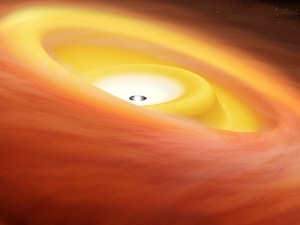Jan 2 2019
For the first time, scientists have observed a warped disk surrounding an infant protostar that formed merely several tens of thousands of years ago. The researchers achieved this by using observations from the ALMA radio observatory in Chile.
 Artist’s conception of the warped disk around the protostar. (Image credit: RIKEN)
Artist’s conception of the warped disk around the protostar. (Image credit: RIKEN)
This suggests that distortions in the planet-forming disk much early in their existence could be the reason for the misalignment of planetary orbits in various planetary systems, including the solar system.
In the solar system, the planets orbit the sun in planes that are at the very most nearly 7° offset from the equator of the sun itself. For some time, it has been understood that several extrasolar systems include planets that are not lined up in a single plane or with the equator of the star. One interpretation for this is that it is possible that certain planets have been affected by collisions with other objects in the system or by stars that pass through the system, expelling them from their initial orbital plane.
However, there was a possibility that the planets were formed out of the normal plane in fact due to a warping of the star-forming cloud from which the planets were born. In the recent times, images of protoplanetary disks—rotating disks at which planets are formed around a star—have actually exhibited such warping. However, it was still obscure how early this took place.
According to the latest discovery, reported in Nature, the team of researchers from the RIKEN Cluster for Pioneering Research (CPR) and Chiba University in Japan has observed that L1527—an infant protostar still embedded within a cloud—has a disk made of two parts—an inner part rotating in one plane, and an outer part rotating in a different plane. The disk is quite young and still enlarging. L1527 is located nearly 450 light-years away in the Taurus Molecular Cloud and is an excellent object for study since it includes a disk that is almost edge-on to the view of humans.
This observation shows that it is conceivable that the misalignment of planetary orbits can be caused by a warp structure formed in the earliest stages of planetary formation. We will have to investigate more systems to find out if this is a common phenomenon or not.
Nami Sakai, Research Head, RIKEN.
The question remains what led to the warping of the disk. Sakai proposes two reasonable interpretations.
One possibility, is that irregularities in the flow of gas and dust in the protostellar cloud are still preserved and manifest themselves as the warped disk. A second possibility is that the magnetic field of the protostar is in a different plane from the rotational plane of the disk, and that the inner disk is being pulled into a different plane from the rest of the disk by the magnetic field.
Nami Sakai, Research Head, RIKEN.
Sakai stated that the team has planned for further study to determine what caused the warping of the disk.
The ALMA observatory in Chile is managed by an international consortium including the National Astronomical Observatory of Japan (NAOJ).